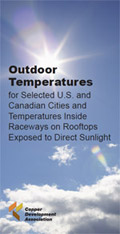The National Electrical Code Section 310.15(A)(3), and good design practice, requires adjustment of ampacity of wires and cables installed in ambient temperature conditions that are higher than those upon which the listed ampacities of Table 310.15(B)(16) are based. Ambient temperature is understood to mean the temperature of the air surrounding the conductor. For conductors in raceway, the ambient to which the insulated conductor is subjected is the temperature of the air inside the raceway.
Ambient temperatures within raceways above rooftops will vary with height, in accordance with Table 310.15(B)(3)(c). After determination of the resultant ambient temperature within the raceway, Table 310.15(B)(2)(a) should be applied.
Outdoor and Rooftop Temperature Table
To help determine the temperature insulation will be subjected to-under unloaded conditions-CDA has compiled a table of average outdoor temperatures (Table 310.15(B)(2)(a)) for various U.S. and selected Canadian cities [PDF - 670Kb], as well as temperatures inside raceway on and at various heights above rooftops in accordance with Table 315(B)(3)(c).
For each city, the table contains:
- An average of the 2% ASHRAE design temperatures for each location for June through August*
- Likely resultant temperatures inside rooftop raceway (unloaded) exposed to direct sunlight in accordance with Table 315(B)(3)(c):
- On the roof, and up to ½ inch above roof
- Greater than ½ inch and up to 3½ inches above roof
- Greater than 3½ inches and up to 12 inches above roof
- Greater than 12 inches and up to 36 inches above roof
- ASHRAE's reported "extreme annual design condition"-i.e., the maximum dry-bulb temperature reading for the location expected within a 50 year period.
The table indicates the 2% design temperature (averaged for June-August) for various cities and the various temperatures inside raceway on rooftops exposed to direct sunlight.
The first column represents the ASHRAE 2% design temperature averaged for June - August. 1 The second through fifth column is the resultant ambient temperature inside the raceway unloaded at specified heights above the roof. 2 The right-hand column is the maximum dry-bulb design temperature for that city, based on 50 years distribution of weather data.
Download Outdoor Temperatures Table [PDF - 670Kb]
- This table is also available in booklet form (Publication A6116).
- View the entire Electrical Publications list online.
1. ASHRAE bases its "warm-season temperature conditions" for each city on annual percentiles of 0.4%, 2 %, 5% and 10%. As an example, the June 2.0% dry-bulb design temperature for Atlanta is 91.7°F. Therefore, based on a 30-day month (i.e., 720 hours), the actual temperatures can be expected to exceed 91.7°F for total of 14 hours a month. The corresponding 5.0% design temperature (89.3°F) can be expected to be exceeded for 36 hours a month; while the 0.4% design temperature (94.7°F) can be expected to be exceeded for 3 hours a month.
2. Calculations shown in the table are based on ASHRAE 2% design temperatures for 10 years of data* and CDA research covering over five years of monitoring air temperatures inside rooftop raceways.** The table uses the average of the June through August dry-bulb design temperatures-generally the hottest months of the year-in calculating the design temperatures in this table. All temperatures are rounded to the nearest whole number. The results can then be used to apply the correction factors in Table 310.15(B)(2)(a) of the National Electrical Code.
*ASHRAE has compiled 10 years of dry-bulb design temperature data in the 2009 ASHRAE Handbook of Fundamentals (The American Society of Heating, Refrigerating and Air-Conditioning Engineers. Chapter 14, Climatic Design Information). The table covers most of the U.S. and selected Canadian weather station locations included in the ASHRAE Handbook. The complete Handbook can be ordered directly from ASHRAE ( www.ashrae.org). (CDA recommends the CD format, Product Code 81092, to obtain complete climatic conditions.)
**The research is described in an article written for the International Association of Electrical Inspectors-IAEI News, Effect of Rooftop Exposure on Ambient Temperatures Inside Conduits, January-February, 2006, and published in IEEE Transactions on Industry Applications, Vol. 44, No. 6, November/December 2008.

